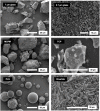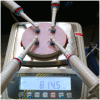Monomer conversion, dimensional stability, strength, modulus, surface apatite precipitation and wear of novel, reactive calcium phosphate and polylysine-containing dental composites
- PMID: 29136013
- PMCID: PMC5685583
- DOI: 10.1371/journal.pone.0187757
Monomer conversion, dimensional stability, strength, modulus, surface apatite precipitation and wear of novel, reactive calcium phosphate and polylysine-containing dental composites
Abstract
Purpose: The aim was to assess monomer conversion, dimensional stability, flexural strength / modulus, surface apatite precipitation and wear of mono / tri calcium phosphate (CaP) and polylysine (PLS)-containing dental composites. These were formulated using a new, high molecular weight, fluid monomer phase that requires no polymerisation activator.
Materials and methods: Urethane and Polypropylene Glycol Dimethacrylates were combined with low levels of an adhesion promoting monomer and a light activated initiator. This liquid was mixed with a hybrid glass containing either 10 wt% CaP and 1 wt% PLS (F1) or 20 wt% CaP and 2 wt% PLS (F2). Powder to liquid mass ratio was 5:1. Commercial controls included Gradia Direct Posterior (GD) and Filtek Z250 (FZ). Monomer conversion and polymerisation shrinkage were calculated using Fourier Transform Infrared (FTIR). Subsequent volume increases in water over 7 weeks were determined using gravimetric studies. Biaxial flexural strength (BFS) / modulus (BFM) reduction and surface apatite precipitation upon 1 and 4 weeks immersion in water versus simulated body fluid (SBF) were assessed using a mechanical testing frame and scanning electron microscope (SEM). Mass / volume loss and surface roughness (Ra) following 7 weeks water immersion and subsequent accelerated tooth-brush abrasion were examined using gravimetric studies and profilometer.
Results: F1 and F2 exhibited much higher monomer conversion (72%) than FZ (54%) and low calculated polymerization shrinkage (2.2 vol%). Final hygroscopic expansions decreased in the order; F2 (3.5 vol%) > F1 (1.8 vol%) ~ Z250 (1.6 vol%) > Gradia (1.0 vol%). BFS and BFM were unaffected by storage medium type. Average BFS / BFM upon 4 weeks immersion reduced from 144 MPa / 8 GPa to 107 MPa / 5 GPa for F1 and 105 MPa / 6 GPa to 82 MPa / 4 GPa for F2. Much of this change was observed in the first week of immersion when water sorption rate was high. Surface apatite layers were incomplete at 1 week, but around 2 and 15 micron thick for F1 and F2 respectively following 4 weeks in SBF. Mass and volume loss following wear were equal. Average results for F1 (0.5%), F2 (0.7%), and FZ (0.5%) were comparable but lower than that of GD (1%). Ra, however, decreased in the order; F1 (15 μm) > F2 (11 μm) > GD (9 μm) > FZ (5 μm).
Conclusions: High monomer conversion in combination with large monomer size and lack of amine activator should improve cytocompatibility of the new composites. High monomer molecular weight and powder content enables low polymerisation shrinkage despite high conversion. Increasing active filler provides enhanced swelling to balance shrinkage, which, in combination with greater surface apatite precipitation, may help seal gaps and reduce bacterial microleakage. High monomer conversion also ensures competitive mechanical / wear characteristics despite enhanced water sorption. Furthermore, increased active filler could help reduce surface roughness upon wear.
Conflict of interest statement
Figures







Similar articles
-
Dental Composites with Calcium / Strontium Phosphates and Polylysine.PLoS One. 2016 Oct 11;11(10):e0164653. doi: 10.1371/journal.pone.0164653. eCollection 2016. PLoS One. 2016. PMID: 27727330 Free PMC article.
-
Conversion, shrinkage, water sorption, flexural strength and modulus of re-mineralizing dental composites.Dent Mater. 2015 Nov;31(11):1279-89. doi: 10.1016/j.dental.2015.08.149. Epub 2015 Sep 9. Dent Mater. 2015. PMID: 26361809
-
Polymerization kinetics stability, volumetric changes, apatite precipitation, strontium release and fatigue of novel bone composites for vertebroplasty.PLoS One. 2019 Mar 18;14(3):e0207965. doi: 10.1371/journal.pone.0207965. eCollection 2019. PLoS One. 2019. PMID: 30883564 Free PMC article.
-
Synthesis, monomer conversion, and mechanical properties of polylysine based dental composites.J Mech Behav Biomed Mater. 2024 Mar;151:106398. doi: 10.1016/j.jmbbm.2024.106398. Epub 2024 Jan 14. J Mech Behav Biomed Mater. 2024. PMID: 38237205
-
The effect of varying monocalcium phosphate and polylysine levels on dental composite properties.J Mech Behav Biomed Mater. 2023 Sep;145:106039. doi: 10.1016/j.jmbbm.2023.106039. Epub 2023 Jul 22. J Mech Behav Biomed Mater. 2023. PMID: 37499523 Free PMC article.
Cited by
-
Effect of coffee on color stability and surface roughness of newly introduced single shade resin composite materials.BMC Oral Health. 2023 Apr 22;23(1):236. doi: 10.1186/s12903-023-02942-y. BMC Oral Health. 2023. PMID: 37087507 Free PMC article. Clinical Trial.
-
In Vitro and In Vivo Efficacy of New Composite for Direct Pulp Capping.Biomed Res Int. 2021 Nov 25;2021:8414577. doi: 10.1155/2021/8414577. eCollection 2021. Biomed Res Int. 2021. PMID: 34869772 Free PMC article.
-
Clinical performance of an alkasite-based bioactive restorative in class II cavities: a randomized clinical trial.J Appl Oral Sci. 2023 Jun 23;31:e20230025. doi: 10.1590/1678-7757-2023-0025. eCollection 2023. J Appl Oral Sci. 2023. PMID: 37377309 Free PMC article. Clinical Trial.
-
Effect of Novel Antibacterial Composites on Bacterial Biofilms.J Funct Biomater. 2020 Aug 1;11(3):55. doi: 10.3390/jfb11030055. J Funct Biomater. 2020. PMID: 32752201 Free PMC article.
-
Effects of bioflavonoid-containing mouth rinses on optical properties of tooth-coloured dental restorative materials.Sci Rep. 2022 Jun 15;12(1):9944. doi: 10.1038/s41598-022-14254-2. Sci Rep. 2022. PMID: 35705613 Free PMC article.
References
-
- Bakhurji E, Scott T, Mangione T, Sohn W. Dentists' perspective about dental amalgam: current use and future direction. J Public Health Dent. 2017:n/a–n/a. doi: 10.1111/jphd.12198 - DOI - PubMed
-
- Kopperud SE, Tveit AB, Gaarden T, Sandvik L, Espelid I. Longevity of posterior dental restorations and reasons for failure. Eur J Oral Sci. 2012;120(6):539–48. doi: 10.1111/eos.12004 - DOI - PubMed
-
- Nedeljkovic I, Teughels W, De Munck J, Van Meerbeek B, Van Landuyt KL. Is secondary caries with composites a material-based problem? Dent Mater. 2015;31(11):e247–77. doi: 10.1016/j.dental.2015.09.001 - DOI - PubMed
-
- Jokstad A. Secondary caries and microleakage. Dent Mater. 2016;32(1):11–25. doi: 10.1016/j.dental.2015.09.006 - DOI - PubMed
-
- Aljabo A, Xia W, Liaqat S, Khan MA, Knowles JC, Ashley P, et al. Conversion, shrinkage, water sorption, flexural strength and modulus of re-mineralizing dental composites. Dent Mater. 2015;31(11):1279–89. doi: 10.1016/j.dental.2015.08.149 - DOI - PubMed
MeSH terms
Substances
Grants and funding
LinkOut - more resources
Full Text Sources
Other Literature Sources
Miscellaneous

